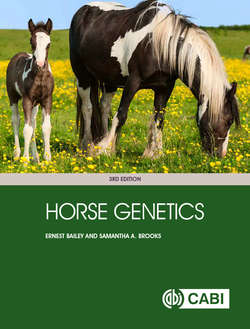Читать книгу Horse Genetics - Ernest Bailey - Страница 69
На сайте Литреса книга снята с продажи.
Breeding heterozygous and homozygous horses
ОглавлениеOne common question is: What are the chances of producing a particular phenotype when mating two horses? If you know the genotypes of the parents you can figure that out using a Punnett square. Reginald Punnett was a scientist in the early 1900s who popularized this form of analysis and has given his name to this approach. To begin with, the genotype tells us precisely what type of gametes a sire and dam will produce. Horses homozygous for E (E/E) will always produce eggs or sperm with the allele for E. Horses homozygous for e (e/e) will always produce eggs or sperm with the e allele. Horses that are heterozygous (E/e) will produce 50% eggs or sperm with E and 50% with e.
A more interesting situation occurs when mating two heterozygotes and this is when the Punnett square becomes useful to visualize the result. Table 5.2 shows a Punnett square for the mating of a heterozygous mare and stallion for the Extension locus. Each of them can produce gametes with ether e or E. Either possibility is equally likely. The sire’s contribution is listed on the left side of the table and his gamete contributions shaded. The squares below and across from the parental contributions are filled in with the result seen in the lower half. The upper left square shows that each parent can contribute the E allele and in this case the offspring will be homozygous E. The lower right square shows that the offspring will inherit the e allele from both parents and be homozygous e. The two other squares (lower left and upper right) show that the offspring could inherit alternate alleles from the parents and be heterozygous (E/e).
Table 5.2. Set-up for a Punnett square to predict genotypes of offspring.
In summary, when mating of two heterozygous parents, there is a 50% chance of producing heterozygous offspring (E/e) that would be phenotypically black since E is dominant, 25% chance of producing homozygous E/E (phenotypically black), and a 25% chance of producing offspring that are homozygous for the recessive allele (ee) and phenotypically chestnut.
You can also use a Punnett square to show the results from mating homozygotes for one allele to a heterozygote. (Hint: chestnut crossed with a heterozygote has a 50% chance of producing chestnut offspring.)
Of course, matings of homozygotes for the same alleles will always produce offspring homozygous for the allele. The parents only have the one allele to transmit to their offspring. Specifically, matings of E/E x E/E will always produce E/E offspring and e/e x e/e always produces e/e offspring. Matings of homozygotes for the opposite alleles will always produce heterozygous offspring because each parent only has the one type of allele to pass to their offspring: E/E x e/e produces all E/e offspring (heterozygotes).
